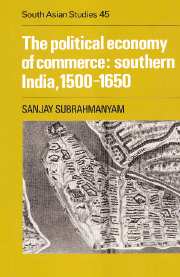Book contents
- Frontmatter
- Contents
- List of illustrations
- List of tables
- Preface
- Abbreviations used
- Introduction
- 1 The political economy of southern India, 1500–1650: preliminary remarks
- 2 Coastal trade and overland trade: complementarities and contradictions
- 3 Overseas trade, 1500–1570: traders, ports and networks
- 4 Overseas trade, 1570–1650: expansion and realignment
- 5 Europeans and Asians in an age of contained conflict
- 6 External commerce and political participation
- 7 Situating trade: models and methodological strategies
- Conclusion
- A note on currency and weights
- Glossary
- Note on sources
- Bibliography
- Index
- CAMBRIDGE SOUTH ASIAN STUDIES
1 - The political economy of southern India, 1500–1650: preliminary remarks
Published online by Cambridge University Press: 13 January 2010
- Frontmatter
- Contents
- List of illustrations
- List of tables
- Preface
- Abbreviations used
- Introduction
- 1 The political economy of southern India, 1500–1650: preliminary remarks
- 2 Coastal trade and overland trade: complementarities and contradictions
- 3 Overseas trade, 1500–1570: traders, ports and networks
- 4 Overseas trade, 1570–1650: expansion and realignment
- 5 Europeans and Asians in an age of contained conflict
- 6 External commerce and political participation
- 7 Situating trade: models and methodological strategies
- Conclusion
- A note on currency and weights
- Glossary
- Note on sources
- Bibliography
- Index
- CAMBRIDGE SOUTH ASIAN STUDIES
Summary
The geographical setting
Peninsular India is dominated by a massive triangular plateau, with its apex to the south, which extends down its centre, beginning from the Vindhya mountains in the north, and extending as far as the tip of the peninsula in a semi-broken form. The Deccan plateau as it is called thus forms the spine of the region here termed south India, and is bordered on either side by strips of low-lying land, the coastal plains. These coastal strips are separated from the elevated flatland of the plateau in the interior by mountain ranges of great antiquity, respectively termed the eastern and western Ghats. Both the ranges are naturally more precipitous in their descent on the low-lying coastal plains than on the interior plateau, given the higher elevation of the interior region; however, the western Ghats are more formidable as a barrier than their eastern counterparts, both in terms of elevation, and in the sheer acuteness of their descent to the coastal plain. Further, the western range preserves a high degree of continuity whereas the hills of the eastern Ghats are not merely more gentle but more broken, with access to the interior from the plain thus being far freer in the east than from the west. Between these two ranges, the interior plateau slopes from the north-west to the south-east, as a consequence determining the general direction of flow of all the major peninsular rivers. Most of these begin to the east of the western Ghats, and flow eastward across the plateau to emerge from the eastern Ghats on to the Coromandel plain, eventually voiding their waters into the Bay of Bengal.
- Type
- Chapter
- Information
- Publisher: Cambridge University PressPrint publication year: 1990



